A step by step guide on how to configure the display settings on a Redbird FMX, MCX, SD or LD.
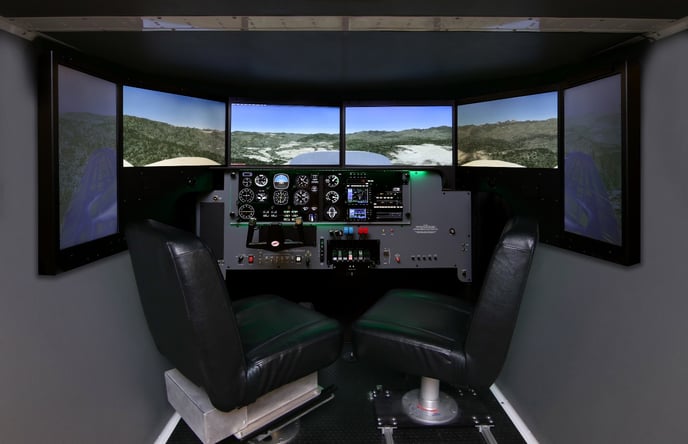
Below are step by step instructions on how to align and configure the monitors on a Redbird FMX, MCX, SD, or LD. These instructions are written for systems running:
- Windows 10
- Redbird Navigator version 3.6.0 (or higher)
For Windows 7, download Legacy instructions here: Aligning and Configuring Monitors
Before you begin:
Ensure that all monitors have video cables connecting them to the video cards on the computer.
Reference the sticker on the top of the computer chassis (above where the video cables connect at the back of the system) for a cable diagram.
Overview/Navigation
- Open the Windows Display Settings menu
- Identify and configure the monitors
- Set the Pilot monitor to be the main/primary display
- Restart the system
Instructions
Open the Windows Display Settings menu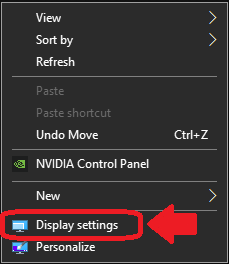
- Connect the all-in-one keyboard provided with the simulator by plugging the cable into the Pilot Key USB port.
- Move the mouse-cursor off of the Redbird Navigator user interface onto the Windows desktop (blank area on a side-monitor).
- Right click, then select Display Settings in the small context menu that appears
- The Windows Display Settings menu should appear.
Identify and configure the monitors
There are several monitor configurations on Redbird AATDs; choose the appropriate section and follow the instructions for your model system.
Version 1: 22in. monitors, equal height in cabin
Version 2: 22in. monitors, lowered wing displays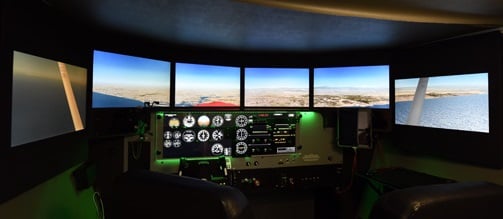
Version 3: 27in. monitors, rotated wing displays: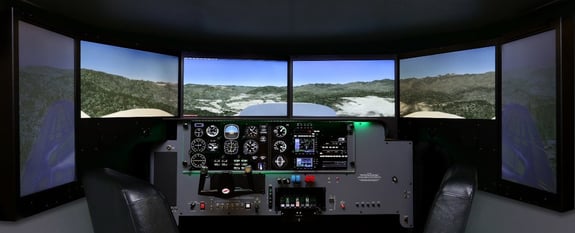
Version 1: 22" monitors, equal height in cabin

- Press the Identify button near the top of the Display Settings menu, beneath the numbered boxes that represent your screens/monitors.
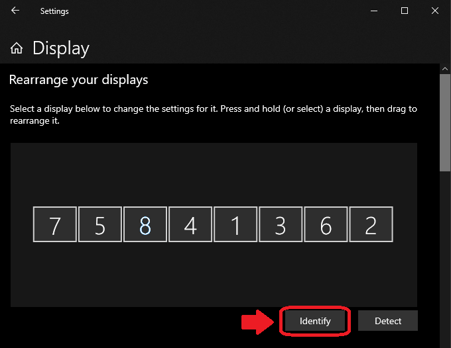
- A number will appear on each of your monitors/screens; take note of which monitor is showing which number.
Note: The numbers on your displays may not match the example shown below.
- Click and drag the numbered boxes in the Windows Display Settings menu to match how your monitors identify, other than the two instrument displays which go to the right of the Right-90° monitor.
Make sure that the top of each monitor lines up with the top of the next; the simulation software draws from the top, so ensuring that the tops of all monitors are lined up makes sure the horizon lines up when you load a flight. The monitors should "snap" to each other when dragged and dropped; but you can use the arrow-keys on the keyboard to adjust them further if they're not snapping correctly.
Note: The numbers on your displays may not match the example shown below.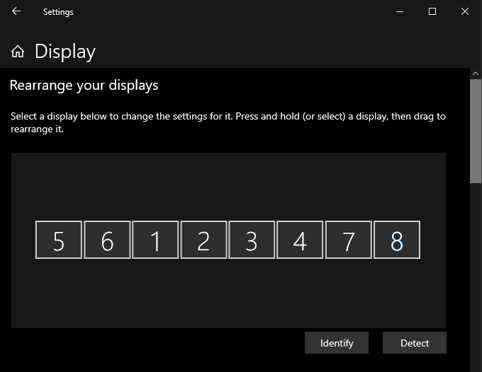 In the provided example, the boxes in the Display Settings menu should be arranged in the following order:
In the provided example, the boxes in the Display Settings menu should be arranged in the following order:
The Left-90° monitor (5) on the left end
The Left-45° monitor (6) next to the right, between 4 and 2
The Pilot monitor (1) next to the right, between 1 and 5
The Copilot monitor (2) next to the right, between 2 and 6
The Right-45° monitor (3) next to the right, between 5 and 7
The Right-90° monitor (4) next to the right, between 6 and 3
The Left Instrument monitor (7) next to the right, between 7 and 8
The Right Instrument monitor (8) at the right end - Select each monitor by clicking on it, then set the appropriate resolution and orientation using the drop-down menus down near the bottom of the Display Settings menu.
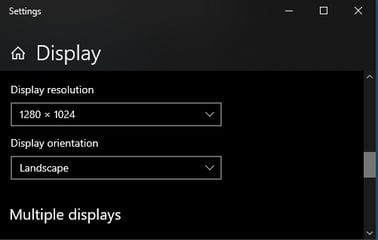 Note: Move the mouse cursor to the right side of the Display Settings menu to make the scrollbar appear if you do not see it.
Note: Move the mouse cursor to the right side of the Display Settings menu to make the scrollbar appear if you do not see it.
Monitor Designation Display Resolution Display Orientation Left-90° 1280 x 1024 Landscape Left-45° 1280 x 1024 Landscape Pilot 1280 x 1024 Landscape Copilot 1280 x 1024 Landscape Right-45° 1280 x 1024 Landscape Right-90° 1280 x 1024 Landscape Left Instrument 1280 x 1024 Landscape Right Instrument 1280 x 1024 Landscape
Version 2: 22" monitors, lowered wing displays

- Press the Identify button near the top of the Display Settings menu, beneath the numbered boxes that represent your screens/monitors.

- A number will appear on each of your monitors/screens; take note of which monitor is showing which number.
Note: The numbers on your displays may not match the example shown below.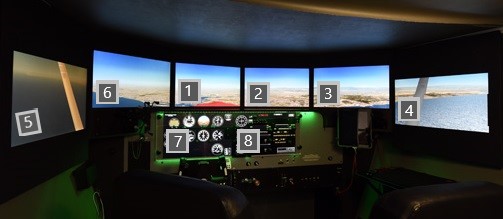
- Click and drag the numbered boxes in the Windows Display Settings menu to match how your monitors identify, other than the two instrument displays which go to the right of the Right-90° monitor.
Make sure that the top of each monitor lines up with the top of the next; the simulation software draws from the top, so ensuring that the tops of all monitors are lined up makes sure the horizon lines up when you load a flight. The monitors should "snap" to each other when dragged and dropped; but you can use the arrow-keys on the keyboard to adjust them further if they're not snapping correctly.
Note: The numbers on your displays may not match the example shown below. In the provided example, the boxes in the Display Settings menu should be arranged in the following order:
In the provided example, the boxes in the Display Settings menu should be arranged in the following order:
The Left-90° monitor (5) on the left end
The Left-45° monitor (6) next to the right, between 4 and 2
The Pilot monitor (1) next to the right, between 1 and 5
The Copilot monitor (2) next to the right, between 2 and 6
The Right-45° monitor (3) next to the right, between 5 and 7
The Right-90° monitor (4) next to the right, between 6 and 3
The Left Instrument monitor (7) next to the right, between 7 and 8
The Right Instrument monitor (8) at the right end
Note: If you have additional horizon expansion monitors, they should go to the left/right of the Left-90° & Right-90° (9 & 10 below), with the instrument displays on the right end.
- Select each monitor by clicking on it, then set the appropriate resolution and orientation using the drop-down menus down near the bottom of the Display Settings menu.
 Note: Move the mouse cursor to the right side of the Display Settings menu to make the scrollbar appear if you do not see it.
Note: Move the mouse cursor to the right side of the Display Settings menu to make the scrollbar appear if you do not see it.
Monitor Designation Display Resolution Display Orientation *Left-120° Horizon 1280 x 1024 Landscape Left-90° 1280 x 1024 Landscape Left-45° 1280 x 1024 Landscape Pilot 1280 x 1024 Landscape Copilot 1280 x 1024 Landscape Right-45° 1280 x 1024 Landscape Right-90° 1280 x 1024 Landscape *Right-120° Horizon 1280 x 1024 Landscape Left Instrument 1280 x 1024 Landscape Right Instrument 1280 x 1024 Landscape *horizon expansion monitors are an optional addon.
Version 3: 27" monitors, rotated wing displays

- Press the Identify button near the top of the Display Settings menu, beneath the numbered boxes that represent your screens/monitors.
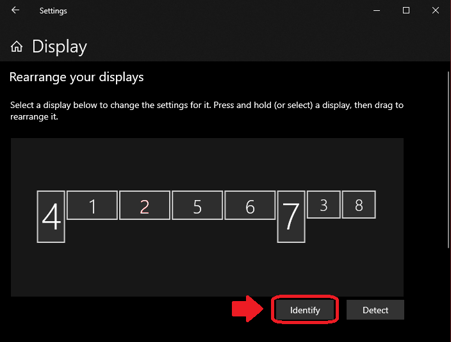
- A number will appear on each of your monitors/screens; take note of which monitor is showing which number.
Note: The numbers on your displays may not match the example shown below.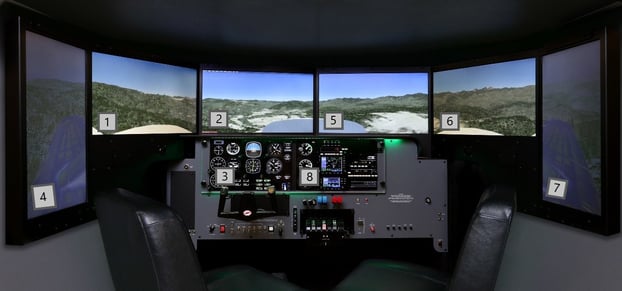
- Click and drag the numbered boxes in the Windows Display Settings menu to match how your monitors identify, other than the two instrument displays which go to the right of the Right-90° monitor.
Make sure that the top of each monitor lines up with the top of the next; the simulation software draws from the top, so ensuring that the tops of all monitors are lined up makes sure the horizon lines up when you load a flight. The monitors should "snap" to each other when dragged and dropped; but you can use the arrow-keys on the keyboard to adjust them further if they're not snapping correctly.
Note: The numbers on your displays may not match the example shown below.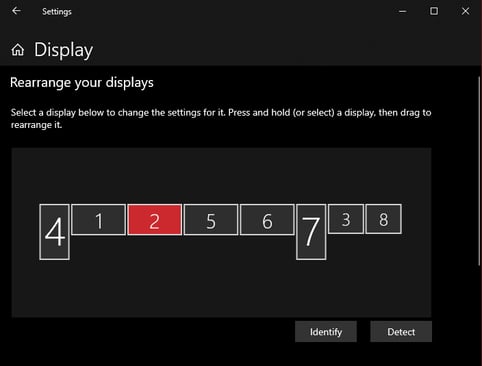 In the provided example, the boxes in the Display Settings menu should be arranged in the following order:
In the provided example, the boxes in the Display Settings menu should be arranged in the following order:
The Left-90° monitor (4) on the left end
The Left-45° monitor (1) next to the right, between 4 and 2
The Pilot monitor (2) next to the right, between 1 and 5
The Copilot monitor (5) next to the right, between 2 and 6
The Right-45° monitor (6) next to the right, between 5 and 7
The Right-90° monitor (7) next to the right, between 6 and 3
The Left Instrument monitor (3) next to the right, between 7 and 8
The Right Instrument monitor (8) at the right end
Note: If you have additional horizon expansion monitors, they should go to the left/right of the Left-90° & Right-90° (9 & 10 below), with the instrument displays on the right end.
- Select each monitor by clicking on it, then set the appropriate resolution and orientation using the drop-down menus down near the bottom of the Display Settings menu.
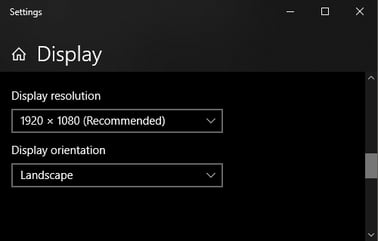 Note: Move the mouse cursor to the right side of the Display Settings menu to make the scrollbar appear if you do not see it.
Note: Move the mouse cursor to the right side of the Display Settings menu to make the scrollbar appear if you do not see it.
Monitor Designation Display Resolution Display Orientation *Left-120° Horizon 1080 x 1920 Portrait Left-90° 1080 x 1920 Portrait Left-45° 1920 x 1080 Landscape Pilot 1920 x 1080 Landscape Copilot 1920 x 1080 Landscape Right-45° 1920 x 1080 Landscape Right-90° 1080 x 1920 Portrait-Flipped *Right-120° Horizon 1080 x 1920 Portrait-Flipped Left Instrument 1280 x 1024 Landscape Right Instrument 1280 x 1024 Landscape *horizon expansion monitors are an optional addon.
Set the Pilot monitor to be the main/primary display
- In the Windows Display Settings menu, select the Pilot screen by clicking on it. The box/screen should change to a lighter color, indicating it has been selected.
Note: The numbers on your displays may not match the example shown below.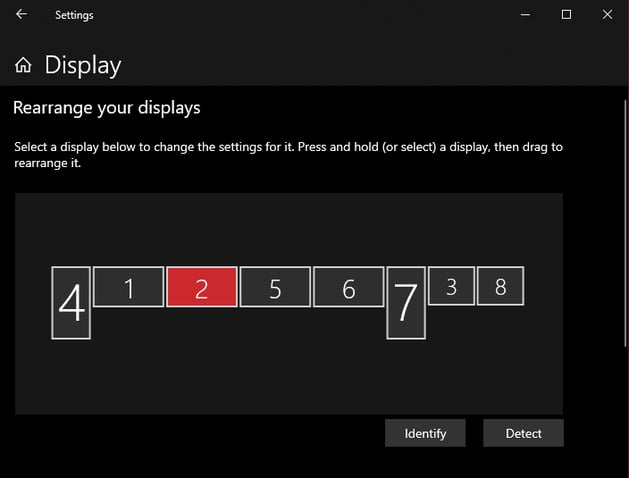
- Scroll down towards the bottom of the Display Settings menu, fill the checkbox next to "Make this my main display"
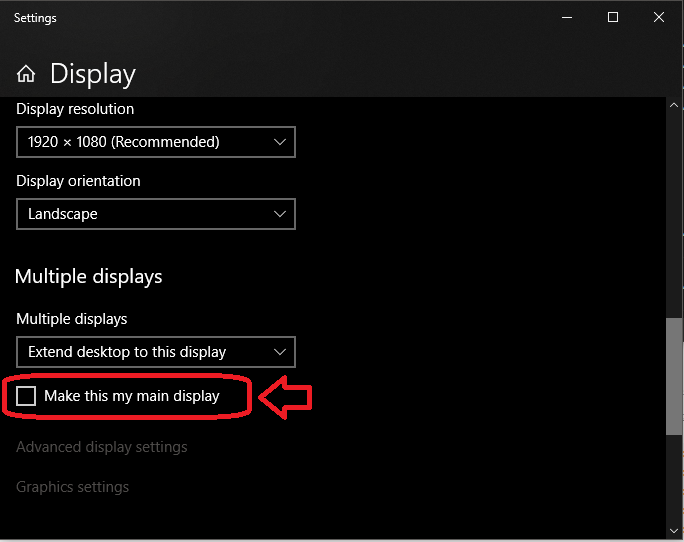
Note: Move the mouse cursor to the right side of the Display Settings menu to make the scrollbar appear if you do not see it.
If the center monitor is already set to be the main display, the checkbox should be filled and the setting should be "greyed out".
Restart the system
Reboot the computer. Once the system reboots, load a test flight to see if the monitors are properly configured.
Note: If your horizon is not level when you load a test flight, make sure that the top of each monitor lines up with the top of the next in the Windows Display Settings menu. Reference step 3 above for instructions.
For assistance, Contact Redbird Support
